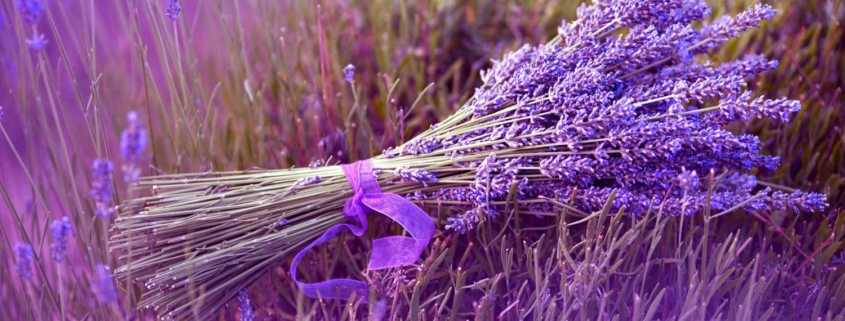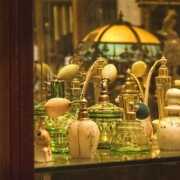Lavender essential oil benefits
Lavender has a long history of being used medicinally. Hildegard von Bingen, a German saint and herbalist who lived from 1098-1179, wrote down that she used a mix of alcohol and lavender in order to treat migraines.
In the 1600s, the Shakers introduced lavender to the Americas. They brought it with them from Europe and are thought to be the first people to start commercially farming it.
But its history goes back some 2500 years.
It is a commonly used ingredient in potpourri, its nectar makes high-quality honey. In the language of flowers, lavender can mean devotion, luck, success, happiness.
Its name derives from the Latin ‘lavare’ meaning ‘to wash”. The Romans used Lavender to scent their baths, beds, clothes, and even hair. They also discovered its medicinal properties. It was also believed that lavender protected against evil fits.
The weird thing is that 16th-century glove makers perfumed their ware with the herb in order not to catch cholera. And the 7th-century thieves who washed in lavender after robbing graves didn’t get the plague!
In the 19th century, gypsy travellers sold bunches of lavender on the streets of London to bring people good luck and protect against ill fortune.
And that’s not all. In Spain and Portugal, it was traditionally strewn on the floor of churches or thrown into bonfires to avert evil spirits on St. John’s Day. In Tuscany, pinning a sprig of lavender to a shirt was a traditional way to ward against the evil eye. Queen Elizabeth I of England had fresh lavender in vases at her table every day.
The Greek physician to the Roman army, Dioscorides, wrote that lavender taken internally would relieve indigestion, sore throats, headaches, and externally cleaned wounds. So the Romans named the plant after its use in their bathing rituals realizing lavender isn’t only relaxing, but also antiseptic.
The 16th-century English herbalist John Parkinson wrote that lavender was “especially good use for all griefes and pains of the head and brain,” and Charles VI of France insisted his pillow always contain lavender so he could get a good night’s sleep. No wonder why some people still use lavender in pillows today.
In Asian traditional medicine, lavender has long been used for its “cooling” effect and for helping the “Shen,” or mind, by cooling the heart, helping people relax and find relief from troubles of the mind that give rise to tension in the body.
In more recent history, lavender became famous for its skin healing when René-Maurice Gattefossé, the 1930s French chemist, burned his hand in his laboratory. He applied lavender oil to treat the burn and was so impressed by the quick healing process. Since Lavender was used by doctors during WWII to heal wounds.
At the same time, a French biochemist, Marguerite Maury, developed a unique method of applying these oils to the skin with massage — hence the practice of aromatherapy massage, now used all over the world.
Today Lavender continues to be cultivated across its countries of origin as well as Europe, Australia, New Zealand, North and South America. Its widespread presence is understandable due to its beautiful flowers, its alluring scent and its extensive uses.
Lavender’s association with love extends from Cleopatra to modern times. Tutankhamun’s tomb contained traces of still-fragrant lavender, and it’s said Cleopatra used lavender to seduce Julius Caesar and Mark Antony.
Not so long ago, ladies wore small lavender pouches in their cleavage to lure suitors.
Lavender works its relaxing magic all around us from garden borders to bath bombs to fabric softener.
People associate lavender with two specific traits: its Fragrance and its color. Its flower and the oil derived from it have long histories in herbal medicine.
Since ancient times it has been used as a sedative, to treat migraines, exhaustion and nervous disorders of the heart, due to its high percentage of linalool and linalyl acetate. As an evergreen perennial it is a multipurpose plant.
It grows in warm and dry sites mostly in the Mediterranean. Its essential oil treats insect bites, burns, and sore throats but is mostly used in perfumery as much as fresh lavender.
The vaporized lavender compound linalool must be smelt to exert its calming effects, which could be used to relieve stress and anxiety disorders.
There is no recommended daily dose for lavender essential oil. According to the principles of aromatherapy, breathing in the scent of lavender essential oil or applying lavender essential oil to the skin transmits messages to the limbic system, a brain region known to influence the nervous system and help regulate emotion.
A popular approach involves combining lavender oil with a carrier oil such as jojoba, sweet almond, or olive oil. Once blended with a carrier oil, the lavender essential oil can be massaged into your skin or added to your bath.
You can also sprinkle a few drops onto a cloth or tissue and inhale its aroma, or add the oil to an aromatherapy diffuser or vaporizer.
It is one of the most versatile natural therapies you can get and, unlike quite a few other plants, is safe to use almost throughout pregnancy, during labour and on your newborn baby.
Lavender oil can be added to a bath to help soothe away pregnancy aches and pain and relieve stress.
Massaging with diluted lavender oil during labor has been known to strengthen contractions and helps to relieve panic or stress.
If you are having your baby at home, try vaporizing some lavender oil for a calming atmosphere.
Lavender’s antiseptic properties make it a useful skin barrier against nappy rash. Diluted in a carrier oil.
Lavender water can be used as skin tonic and antiseptic.
On the spiritual side, due to its calming effects, Lavender is a spiritual healer and purifier. The burning of lavender flowers, or of lavender oil, should cleanse the spirit and ease the soul. It will help to cure heartbreak and eases sadness. If you are a healer in Chakras, then lavender is a great tool for you. Blockages within chakras caused by negative energy can cause severe emotional and sometimes physical disruptions. Lavender is a spiritual energy purifier and will release and cleanse these negative energies so that you are balanced again.
Purple is also the color associated with the crown chakra. The crown chakra is associated with our higher purpose and spiritual connections so lavender is an important spiritual herb overall.
Rub the arches of your feet with oil to clear your energetic field
Apply a drop of oil to the top of your forehead and anoint your forehead in a downward motion to bring your spirit into your body and open your crown chakra
Purify your ritual candles and tools with a drop of oil to release any negative energies contained within them
Purify yourself by running a bath and adding 8-10 drops of oil. Soak in the bath for 30 minutes. Balance your energy fields by massaging a little oil gently into the outer ear
Clear your mind by adding oil to a diffuser. Inhale positive energy along with the lavender vapor and exhale negative thoughts. Repeat this until you feel clear and positive.
Aside from Lavender containing linalool, an anxiolytic agent which will ease anxiety, lavender has also been known to help people suffering from dementia. It is an analgesic, it provides pain relief by blocking the production of prostaglandins. These constrict blood vessels, which restrict blood flow through the body. This, in turn, can increase body heat, which can cause fever. By restricting the production of prostaglandins, analgesics can reduce fever, inflammation and pain. It is great for headaches and to soothe migraines due to these properties
It is flowering season is June-August. Be ready to crop some for your personal use.
It is commonly grown as an ornamental plant. It is popular for its colorful flowers, its fragrance and its ability to survive with little water. It does not grow well in damp soil. It is fairly tolerant of low temperatures. It tolerates acid soils but favors neutral to alkaline soils. Lavender plants produce seeds but propagation is done by cutting or root divisions
Most lavender plants are blue or purple, but there are some varieties that come in pink and yellow
As a member of the mint family, Lavender has been used for centuries in the preparation of food either by itself or as an ingredient of Herbs de Province.
Lavender delivers a floral, slightly sweet flavor to salads, soups, meat and seafood dishes, and confectionery just to name a few. For most cooking, it is the dried flowers that are used although the leaves may also be used.
The most common way lavender is consumed is by brewing a tea from its buds. By Boiling 8 oz of water. Placing 4 tsp. of fresh lavender buds into a tea ball or sachet. Placing the tea ball and water into a teacup. Let steep for 10 minutes. And that’s it. Have a special tea time.






















Leave a Reply
Want to join the discussion?Feel free to contribute!